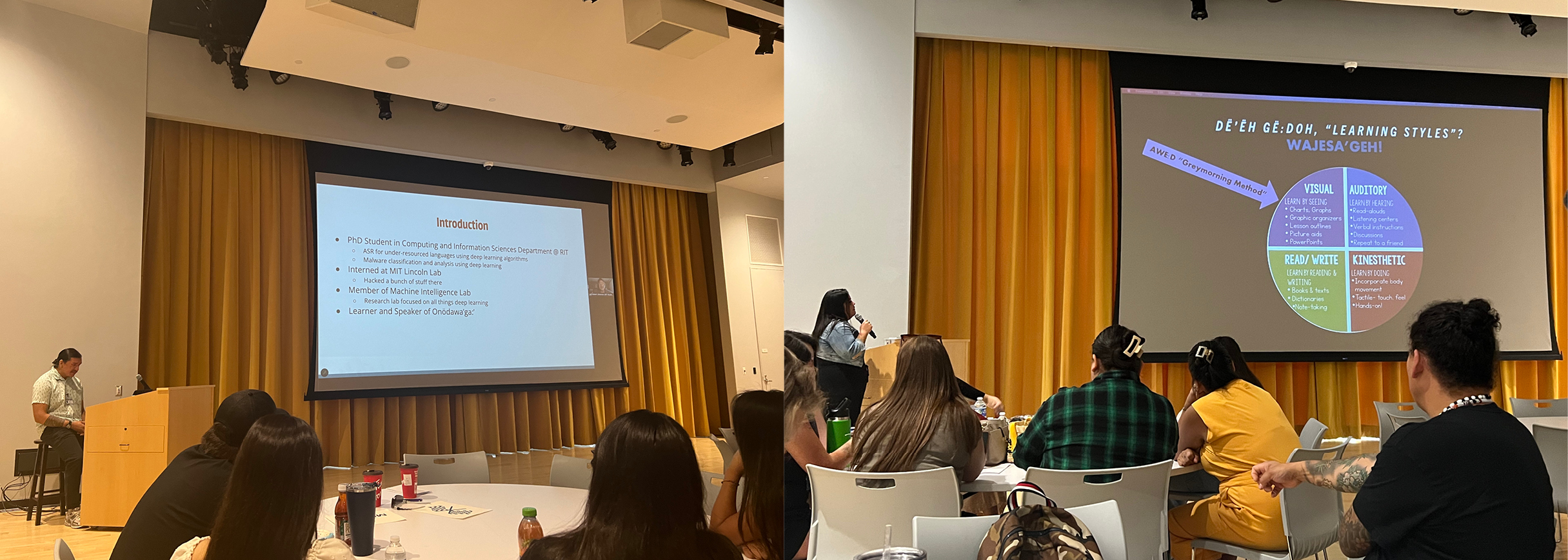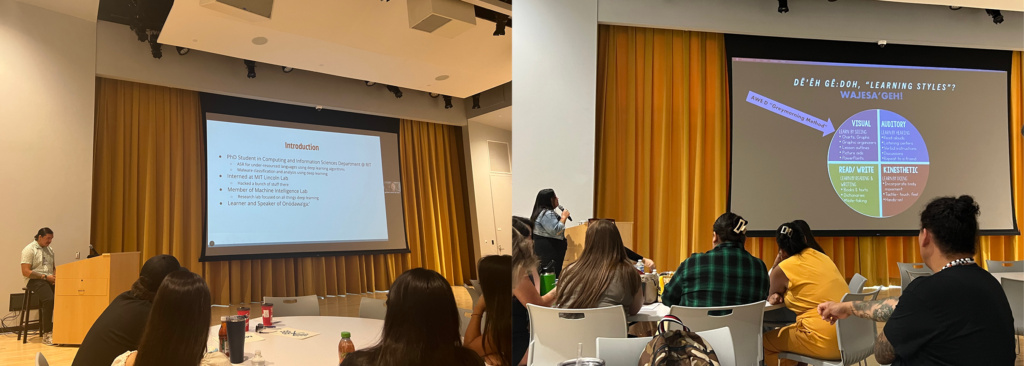“Indigenous languages are not relics of the past.”
A collaborative effort between the Future Stewards Program and the RIT Department of Modern Languages and Culture has resulted in the Indigenous language and culture education, preservation and revitalization project, which co-sponsored the inaugural Ganödagë:n Seneca Language Symposium held at Ganondagan over the summer.

Kendall Scott (Kickapoo), director of RIT’s Future Stewards Program was one of several from RIT who attended and says, “Indigenous languages are not mere modes of communication; they are vessels of traditional wisdom.”
As we celebrate Native American Heritage Month, we asked Scott a number of questions beginning with why he feels it is important to preserve Indigenous languages and if it is a lost art, especially among young people.
Kendall Scott: The preservation of Indigenous languages is essential as it serves to safeguard the cultural heritage, traditional knowledge, and identity of Indigenous communities. These languages are repositories of ancestral wisdom, fostering community cohesion and providing unique avenues for self-expression. Their preservation is not only a matter of cultural significance but also a human rights imperative, recognizing the diversity of languages as an integral part of our global heritage.
No, I don’t find it a lost art either. Instead, I see it as a process of reclaiming a vital part of American Indian identity. Historically, practices of the U.S. government aimed to assimilate Indigenous communities such as Richard Henry Pratt’s “Kill the Indian, Save the Man” education model, resulting in the loss of many languages. Today, there’s a resurgence in efforts to reclaim and revitalize these languages, mending the cultural fabric that was once intentionally disrupted. It’s a powerful testament to the resilience and determination of Indigenous communities to preserve their linguistic and cultural heritage.
Marked by the forced assimilation and suppression of Indigenous languages and cultures in the United States, serves as a stark reminder of the deep trauma inflicted upon Indigenous communities. I believe we are now in a period of healing, and as someone working in education, I’ve witnessed countless Indigenous students grappling with the loss of their languages and cultural identity. This loss is a direct result of the U.S. government’s policies, which included forced assimilation and the establishment of reservations. However, I remain hopeful for the future. Programs like the RIT Native American Future Stewards are instrumental in this healing process. They provide Indigenous students with the means to reconnect with their cultural heritage, languages, and traditions. By doing so, these programs contribute to rebuilding what was lost due to colonization. Our collective efforts aim to empower the next generation to embrace their heritage with pride and resilience. Together, we are working towards a brighter and more inclusive future that honors the rich tapestry of Indigenous cultures and languages.
Question: Would people be surprised to learn the number of Indigenous languages that exist? Give us some examples?
Kendall Scott: Many people would be indeed surprised to learn about the vast number of Indigenous languages that exist worldwide. It’s estimated that there are over 7,000 languages spoken globally, and a significant portion of them are Indigenous languages. According to the Indigenous Language Institute, the United States once had over 300 Indigenous languages in use before Christopher Columbus’ arrival, but today, only about 175 of them persist. Their projections suggest that without active restoration efforts, by 2050, only around 20 of these languages may still be spoken.
In the United States, there are approximately 574 federally recognized tribes and many more state-recognized tribes. Each of these tribes has its own distinct language or dialect. The exact number of Indigenous languages in the United States can be challenging to determine due to factors like language revitalization efforts and the evolving nature of languages.
Question: Taking part in Indigenous cultural activities may be one way to preserve language and culture but is that enough? What role does the family play?
Kendall Scott: Participating in Indigenous cultural activities is indeed a valuable way to preserve languages and culture, but it may not be enough on its own. The role of the family is crucial in language preservation. Children often learn their first language within the family. If Indigenous languages are not spoken in the home, it can hinder the transmission of these languages to the next generation. An immersive home environment helps reinforce language skills learned elsewhere, such as in language schools or cultural activities. Indigenous languages thrive when they are passed down from older generations to younger ones. Family members, especially grandparents, often hold deep linguistic and cultural knowledge that they can impart to their grandchildren. In the context of Western New York and the Haudenosaunee, incorporating their languages into activities like lacrosse is a meaningful step. This not only connects language with a beloved tradition but also creates a practical and immersive learning environment. However, for long-term language preservation, it’s vital for families to actively use these languages in their daily lives. Language schools and cultural activities can provide important support, but the home remains the heart of language transmission.
The preservation of Indigenous languages is a matter of profound significance, encompassing cultural identity, historical reconciliation, and the conservation of invaluable knowledge. These languages are the vibrant threads that weave together the cultural tapestry of Indigenous communities, serving as living repositories of traditions, values, and heritage. They bear witness to a history marred by colonization and cultural genocide, making their preservation a step towards acknowledging past injustices and fostering healing. Indigenous languages are not mere modes of communication; they are vessels of traditional wisdom. Within their lexicons lie centuries of knowledge about the natural world, medicinal practices, and sustainable interactions with the environment. Moreover, the revitalization of Indigenous languages has a profound impact on mental and emotional well-being. Speaking one’s native language fosters pride, self-esteem, and a sense of belonging within Indigenous communities. By incorporating these languages into education, we empower future generations to embrace their cultural heritage while preparing them for the challenges of the modern world. Crucially, Indigenous languages are not relics of the past; they adapt to modern technology and digital platforms, ensuring their relevance in the digital age. This adaptability allows Indigenous cultures to thrive in contemporary society. This is not a localized issue; it’s a global imperative. Indigenous communities worldwide face similar challenges and opportunities in preserving their languages. International collaboration and awareness are essential in this endeavor. In conclusion, preserving Indigenous languages is a multifaceted mission that bridges cultural divides, acknowledges historical injustices, safeguards traditional wisdom, and enhances well-being. It is a profound and necessary undertaking with far-reaching implications, enriching both Indigenous communities and our collective understanding of the world.



